Contacts
For more information, please contact Darren Buck.
(with additional slides for recreational trail context, corrections to accessibility information,
and slides for recreational bridges)
(Download Powerpoint Version / 4.9 MB)
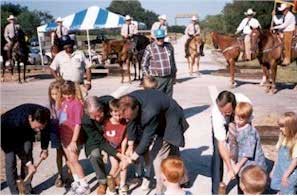
Photo: Transportation Alternatives Data Exchange (TrADE).
Mineral Wells to Weatherford Rail-Trail, Mineral Wells, TX.
Opening day and dedication of the Mineral Wells to Weatherford Rail. (Photo: Texas DOT).
Transportation Alternatives Program
Recreational Trails Program
Federal Highway Administration
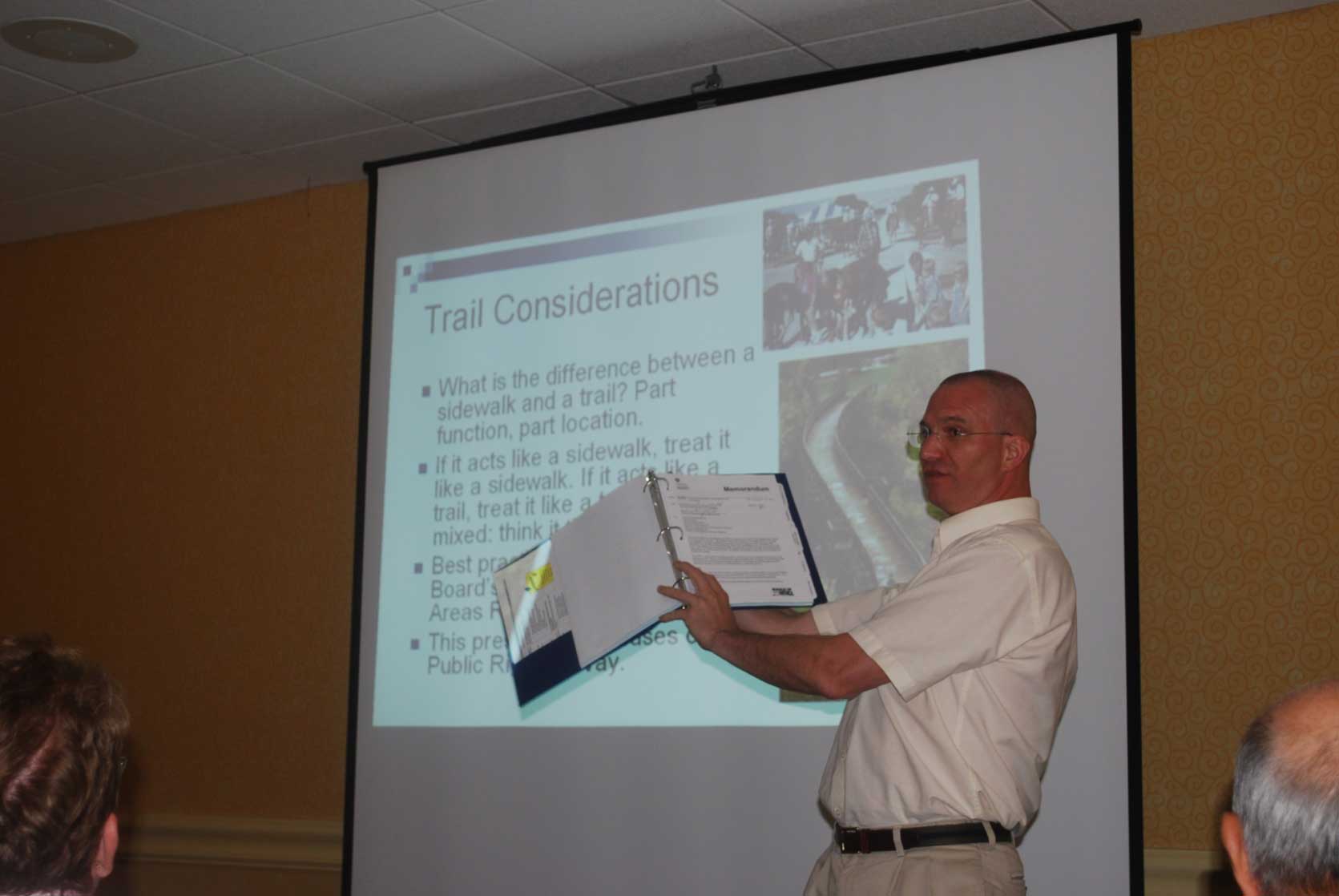
Photo of Christopher Douwes, Community Planner, FHWA, presenting at FHWA Civil Rights Discipline Training, June 23, 2009, Albuquerque NM. Photo: Henry Droughter, Equal Opportunity Specialist, FHWA Pennsylvania Division
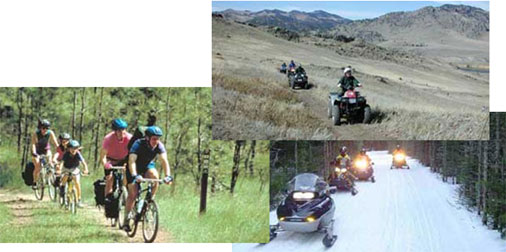
Photos from the Recreational Trails Program website.
Left: Mountain bike trails at Butte State Park, Montana.
Top right: ATV trail on the Bull Run Guest Ranch near Cascade, Montana.
Bottom right: Snowmobiles at Eagle River, Wisconsin.
What is a recreational trail?
A thoroughfare or track across land or snow, used for recreational purposes:
What is the difference between a shared use path and a trail?
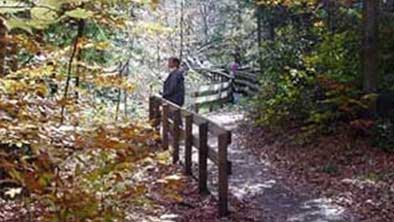
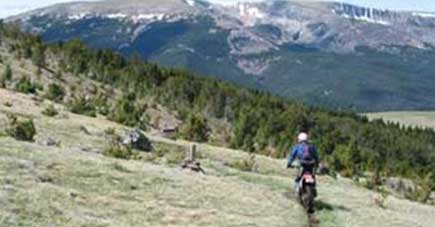
Photos from the Recreational Trails Program website
Left: Visitors enjoy a fenced trail near the Cycling the Pass stop on McKenzie Pass - Santiam Pass Scenic Byway, Oregon.
Right: Two-wheeling in the Lewis and Clark National Forest near Neihart, Montana.
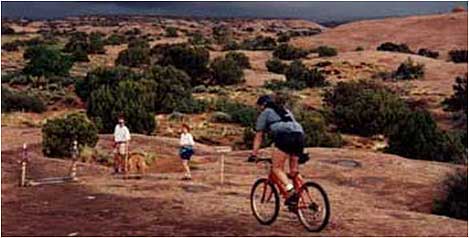
Photo from the Recreational Trails Program website.
Hikers and bikers both enjoy the Slickrock Trail in Moab, Utah,
despite threatening storm clouds from the north.
©2000. A. Crane.
What is the trail purpose?
Accessibility: See www.access-board.gov/guidelines-and-standards/recreation-facilities/outdoor-developed-areas.
Outdoor Developed Areas: The U.S. Access Board developed standards for Outdoor Developed Areas, see www.access-board.gov/guidelines-and-standards/recreation-facilities/outdoor-developed-areas. These guidelines are for recreational trails (trails not intended for a transportation purpose), outdoor recreation access routes, picnic and camping facilities, and beach access routes.
Federal Lands and Federal Agencies (except Forest Service): Use the Access Board's Final Guidelines for Outdoor Developed Areas, published on September 26, 2013, under the Architectural Barriers Act (ABA) of 1968. These guidelines apply to projects on Federal lands or constructed by a Federal agency.
Forest Service: Use the Forest Service Trails Accessibility Guidelines (FSTAG) and Accessibility Guidebook on Outdoor Recreation and Trails. These guidelines comply with the Final Guidelines for Outdoor Developed Areas. The Forest Service guidelines are legally enforceable on National Forest System lands. Although the guidelines are official policy only for the Forest Service, they contain useful concepts to help other agencies and organizations maximize accessibility without changing the setting in outdoor recreation areas and on trails. The Accessibility Guidebook on Outdoor Recreation and Trails provides "how-to" information to integrate accessibility into outdoor recreation site and trail projects.
Projects constructed with or without Federal-aid funding by a State or local government, or a private entity, and not located on Federal lands: There are no officially proposed guidelines for outdoor developed areas under the ADA. However, in the absence of a standard, accessibility must still be provided under the ADA. The Access Board's Final Guidelines for Outdoor Developed Areas and the Forest Service Trails Accessibility Guidelines (FSTAG) and Accessibility Guidebook on Outdoor Recreation and Trails are best practices that State and local governments and private entities may use.
The Outdoor Developed Areas guidelines are not appropriate for trails intended for transportation purposes: use the proposed PROWAG / Shared Use Paths guidelines.
Recreation facilities (other than trails): Use the Access Board's Requirements for Recreation Facilities at www.access-board.gov/guidelines-and-standards/recreation-facilities/about-recreation-facilities. It would be relatively rare for FHWA to be involved with these projects, because most of these facilities are not eligible under Federal-aid highway programs unless required as environmental mitigation.
Surface: Firm and stable for accessibility.
But not all recreational trails will be accessible.
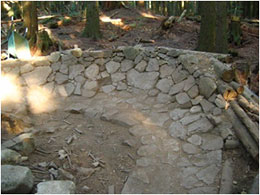
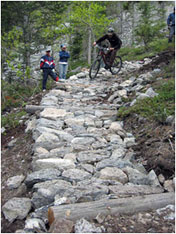
Photos: From International Mountain Bicycling Association.
Publication developed with funding in part through FHWA's Recreational Trails Program.
Surface: Likely not paved.
Tread Obstacles may exist:
Gaps: Usually in bridges and boardwalks. Keep <0.5 inches, or <0.75 inches by exception.
ATVs: All-terrain vehicles
ROV: Recreational Off-road Vehicle
UTV: Utility Vehicle
The "half rule" is not a "rule". It is a consideration, and might not work depending on soils, surrounding terrain, rainfall, expected use, etc.
Grade reversals stop water flowing down the trail.
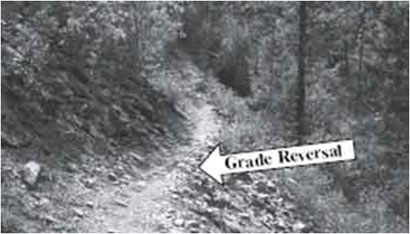

Photo: USDA Forest Service, Trail Construction and Maintenance Notebook.
Drawing: International Mountain Bicycling Association.
Easy way to get water off an existing trail.
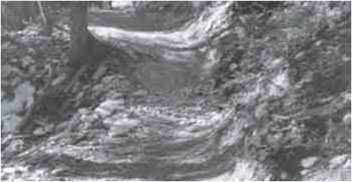
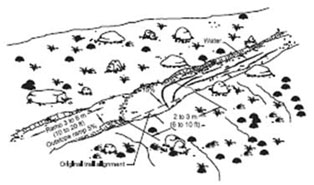
Photo and Drawing from USDA Forest Service, Trail Construction and Maintenance Notebook.
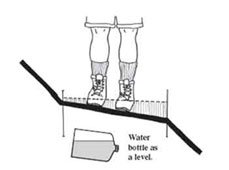
| PROW | ORAR | Trail | |
| General: | 2% | 3% | 5%, 3% preferred |
| Exception: | 5%* | 5%** | 10%** |
* At street crossings without stop control or at midblock.
** If needed for drainage on an unpaved surface.
If your ankles start to roll, the tread has too much outslope.
Drawing from USDA Forest Service, Trail Construction and Maintenance Notebook.
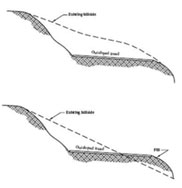
Prefer a "full bench cut" over a "half bench" cut.
Drawings from USDA Forest Service, Trail Construction and Maintenance Notebook.

Drawing from USDA Forest Service, Trail Construction and Maintenance Notebook.

Photo and Drawing from USDA Forest Service, Trail Construction and Maintenance Notebook.
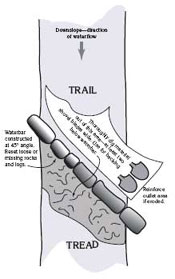
Drawing from USDA Forest Service, Trail Construction and Maintenance Notebook.


